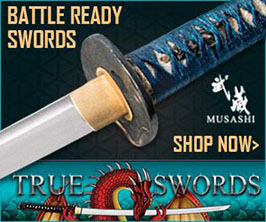Two pegs? or not two pegs? that is my question. (bad pun intended)
by Jason Roland
(Novi, Mi USA)
QUESTION: I want to start by saying that I appreciate what you're doing and I definately consider your page an awsome resource for swords information and locating swords in my primary price range. But I did notice a discrepancy and I was wondering if you could further elaborate. In your first post you mention that the single peg security worries you, but in your seccond post, speaking on the Sam Sung Katana, you just pass it by as being a standard feature of a traditional Katana. Why did it worry you with the first, and not with the seccond. (as a personal preference, I prefer 2 pegs, but I enjoy redundancy)
(1) https://www.sword-buyers-guide.com/cheap-samurai-swords-for-sale.html
(2) https://www.sword-buyers-guide.com/authentic-japanese-sword.html
ANSWER: Good point Jason. At first glance, it does seem kind of contradictory. However there is a method to my madness. ;-)
In a traditional Katana - there is only 1 peg. The reason why is because the tsuka (handle) is made specifically for the nagako (tang) so that they achieve a close friction fit. Then the peg goes through for reinforcement and as a failsafe, and it works perfectly.
Cheap production swords (by cheap, I mean under around $600!) tend not to be so well fitted. So the additional peg is added as a failsafe to make up for a fit that can often be too tight or too lose.
There is some controversy in the JSA community about which method is best. Some think that all swords that are not fitted properly with a friction fit and single peg should simply be avoided. Others think that cheap swords should be epoxied to prevent any possible hilt failure (such as the old model Hanwei PK and some of the Musashi swords).
Some sensei think that the second peg should be copper or brass, such as those used by Cheness Cutlery. Some others, such as Last Legend, tend to use three pegs - but most agree that this is overkill...
My own thoughts, at the lowest end of the scale - two pegs or epoxy are the way to go, though the best way is a good friction fit and one peg - but this only really works on high end swords (though there are a few exceptions).
I know it sounds a bit convoluted, and I have probably raised more questions than I have answered. But I hope you get the general idea.
Cheers,
- Paul













